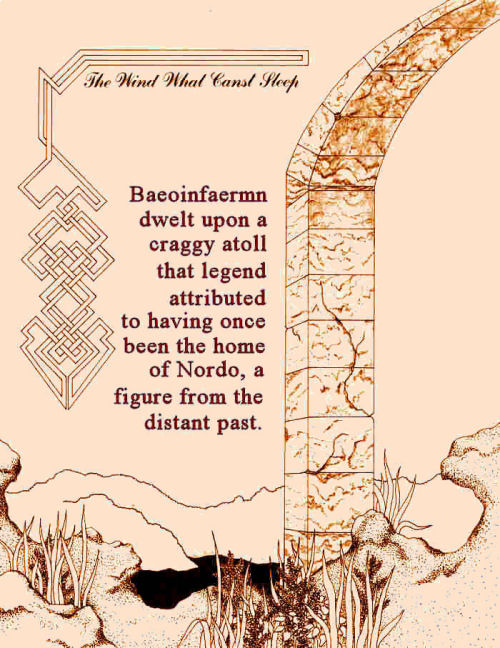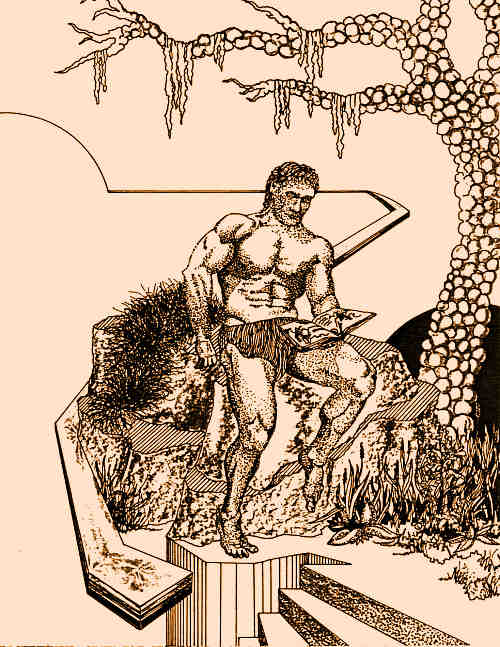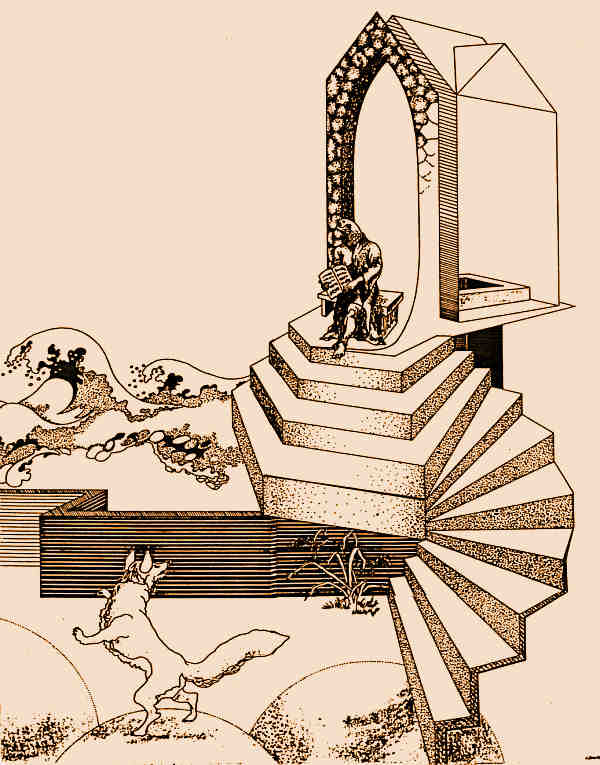



| Baeoinfaermn dwelt upon a craggy atoll that legend attributed to having once been the home of Nordo, a figure from the distant past. This one whom the Lunn called The Wind What Canst Sleep was very much like the legendary Nordo in his mastery of the various occult and visual arts, and so his presence on the lone atoll was nothing out of the ordinary. It was even rumoured that the young man was descended from Nordo, but many of the Lunn regarded this as far-fetched because they did not believe that there ever had existed a Nordo of flesh and blood. |
| Time has a way of clouding true facts, and making them appear distorted and enlarged even as the image of a fish in water belies its true shape and size. And so did time wreak havoc on the tales handed down through the generations of the Lunn concerning the artist / alchemist Nordo. |
| The most widespread of these tales, albeit the most unbelievable of them all, told of how this Nordo had been Visited by a dragon of sorts (though not like the dragons which exist today), and had gone insane. It told of how Nordo, having been tortured by the dragon creature with mental torment, destroyed himself and the exotic environment he had previously created. It was told of how splendid his gardens had been, spread out in mesmerizing beauty where now only a wretched lagoon and the craggy atoll lie. It was told that in his moment of destruction Nordo took with him the wonders of his splendid gardens leaving only the lush valleys of the Lunn to be spared owing to his intense love for the Lunn. This was perhaps the most widespread of the Nordo sagas because it gave the people a sense of dignity and noble worth. |
| Some versions of the Nordo tale claim that there had never existed a Nordo nor a lush garden abode, that nothing, save the Lunn's delusions of an art messiah, had been destroyed. These versions claim that the Lunn of old were so caught up in a desire to know the secrets of Art that they experienced a collective hallucination which they molded into the legendary figure called Nordo. Perhaps their mania increased in intensity until it could not bear the weight of their expectations, bursting upon itself, and destroying the dream they called Nordo. |
| But there exist other versions of the Nordo mythos which claim that he was indeed a mortal being like the Lunn, but not truly of their race, a mortal so skilled in all the arts, and knowledgeable far beyond the wildest dreams of any person living then or now, who in his quest to know more, finally reached the point where he passed through the fine curtain of consciousness to wander in a parallel world where all is chaos that is here order, and vice versa. |
| These versions claim that the creature that visited Nordo in the third age (according to the Tarmus Adelme calendar) was a messenger from that parallel realm, sent to provide Nordo with the key to locating a passageway between the two worlds. Certain allegorical tales allude to Nordo ripping his head in two; these may have arisen from this belief that he existed on the brink of the dual realms, and such an action would symbolize his attempt to believe in both of them at the same time. |
| Notwithstanding the fact that many of the legends of Nordo contradict each other somewhat, there was one substantial piece of evidence that the Lunn could not confute so easily which pointed toward a Nordo of flesh and blood as having existed in their midst. This evidence concerned an incident that had occurred in the first quarter of the fourth age. |
| Soon after the series of events which sparked the Lunn to create their fabulous legends of the Nordo figure had passed, a group of children had ventured rather close to the pond of the green mire in their play. There they saw a glistening gold object sparkling upon the atoll. In their fascination they attempted to cross the deceptive mire, and one of them was severely burnt by the acid waters. Fearing a repeat of the tragedy at some future date, a band of menfolk made their way across the treacherous lagoon in boats of reed and pitch tar to get rid of the tempting gold object. |
| According to the townsmen when they returned, wide-eyed and delirious with the basic foundations of what would become the Nordo legends, they had discovered a golden coffer in which lay a book bound in black velvet and thread of silver titled "The Golden Comet And Sundry Winds Of King Nordo". |
| The book contained essays and discourses on the arts. As the read through the book, the writings confused and frightened them. And as they read, they imagined that the air around them was becoming sweetly moist. The rocks beneath their feet seemed to move ever so slightly, and they fancied they heard sounds of rebecs and lutes exuding from the pools of pinkish waters that gurgled near them. The more they read, the more they became aware of these bastardizations of nature. At ill ease, they put the book back into its case, and covered it well with clods of moss so that it might be hid from sight. They returned home empty-handed except for stories they would tell. |
| It was not until a few years ago that anyone dared go to the barren atoll, and even then the first to do so was a traveller who had come to Lunn named Baeoinfaermn. Ignoring the warnings of the simple folk, Baeoinfaermn made his way to the atoll by way of a thorny vale that the Lunn people had always avoided. There, in the gilded box, spoken of by the Lunn, he discovered the fabled book. It was in remarkable shape despite the age that the Lunn claimed it should be. |
| Baeoinfaermn opened the book, and calmly read it, understanding all he found in its depths. Having studied various of the arts in his early life he was able to comprehend the writings that had confused the previous group. Of strange and curious changes in the spaces around him, Baeoinfaermn took no notice, for he was much accustomed to such things. He read the whole of it through without pause, and when he had finished, he placed it back in its gilded box, and carried it to show to the Lunn. |

| When they saw that the book indeed existed, and after Baeoinfaermn explained assured them that its cryptic contents were no harm to them, they realized that regardless of the exact nature of the one who had inscribed its contents, there had actually been some truth in the legends they retold through countless centuries. |
| As he was a stranger to their lands, Baeoinfaermn presented the book and its gilded coffer to the elders of the Lunn. They would not accept it though, rather they desired that it be kept by Baeoinfaermn to use as he would have it. They also desired that he reside in their lands for a while so that he might share with them his knowledge of the arts. |
| He graciously conceded to their requests, and took the book with him back to the atoll. In that accursed place he constructed a shelter wherein he might live. |
| In time he became widely known, not only in Lunn but in the bordering realms, for his mastery of the arts, and tales began to spread of his uncanny similarity to the legendary Nordo. The Lunn often came to his island abode to question him on the arts, and through his advice their lives became enriched to a point that (the historians claim) rivalled that of the third age. Wayfarers from lands beyond the stars came to him, and as a fish out of water he expounded to them upon diverse subjects pertaining to the arts. |

| Baeoinfaermn's fame grew and it finally reached the gates of Ęberaun. It was shortly thereafter, in the dead of night, that the Mardots approached. |
